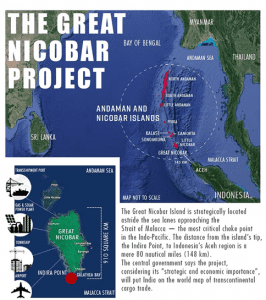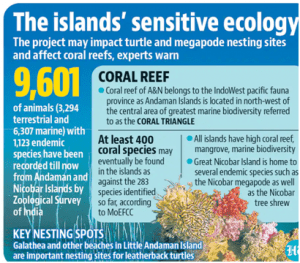Table of Contents
THE CONTEXT: Union Ministry of Environment, Forest and Climate Change (MoEFCC) has cleared the decks for a mega project at the cost of about ₹70,000 crores at the southern tip of the Andaman and Nicobar Islands. ‘Holistic Development of Great Nicobar Islands in Andaman and Nicobar Islands’ project is being spearheaded by the Andaman and Nicobar Islands Integrated Development Corporation under a vision plan conceived by the NITI Aayog, the Centre’s public policy think tank.This article analyses various aspects of this mega projects.
ABOUT THE PROJECT
The ‘Holistic Development of Great Nicobar Island’ project contains the 4 Sub-parts:
- An international transhipment port of 14.2 mTEU cargo capacity at Galathea Bay along the island’s south-eastern coast,
- An international airport to support 4,000 passengers during peak hours,
- A 450 MVA gas and solar-based power plant, and
- An ecotourism and residential township of about 160 sq km.

BACKGROUND OF THE PROJECT
September 2020
During the COVID-19 pandemic, NITI Aayog issued the request for proposals for the “Preparation of Master Plan for Holistic Development of Great Nicobar Island.”
August 2021
AECOM, got the contract and released the pre-feasibility report in March 2021. It was immediately taken up for discussion by the Environment Appraisal Committee – Infrastructure 1 (EAC) which issued the Terms of Reference in May 2021. AECOM also submitted the Preliminary Engineering Design Report of the ITP to NITI Aayog in August 2021.
January 2021
In January 2021, well before the project proponent – Andaman and Nicobar Islands Integrated Development Corporation (ANIIDCO) – even submitted the proposal to the EAC, the Standing Committee of the National Board for Wildlife denotified the Galathea Bay Wildlife Sanctuary to free it as the port site.
In early 2021, the Union Ministry of Environment Forest and Climate Change (MoEFCC) declared a “zero extent” eco-sensitive zone for the Galathea National Park, allowing forest land along its south and south-eastern boundary to be made available for the project.
March, 2022
VIMTA Lab published the final Environmental Impact Assessment (EIA) Report in March, 2022. The project was discussed by the EAC in its meetings in March and May and finally recommended for clearance in its meeting held on August 22-23, 2022.
October 27, 2022
Ministry gave in-principle or Stage 1 Forest Clearance that will involve felling of approximately 8.5 lakh trees in the rich rain forests teeming with extraordinary flora and fauna species. This was done by amending the Rules in haste.
November 4, 2022
MoEFCC granted final Environmental Clearance for the plan.
With this, the decks were cleared to start construction of a port, an international airport, a power plant and a township spread over 166 square km of land.
SIGNIFICANCE OF THE PROJECT
- Strategic Location – Located on the International Trade Route, with existing transhipment terminals like Singapore, Klang and Colombo in proximity.
- Catchment – Potential to capture transhipment cargo from the similar international facilities in the sub-continent and Ports in the proximity including Indian Ports.
- It can attract Indian and regional transhipment traffic from the current hubs, save significant revenue loss, reduce logistics inefficiencies for Indian trade, reduce risks to the country’s export competitiveness and create an opportunity for India to become a large hub for Asia-Africa, Asia-US/Europe container traffic trade. Indian ports can save $200-220 Million each year on transhipment cargo.
- Developing Galathea Bay Transhipment Port will accrue significant benefits such as forex savings, foreign direct investment, increased economic activity at other Indian Ports, enhanced logistics infrastructure and thus, efficiencies, employment generation, and increased revenue share.
- Tourism promotion: Connectivityv will also help in promotion of the tourism in the Nicobar Islands
- Other projects include, Airport, Township & Power plant– aims to bridge the gaps in infrastructure and improve economic opportunity for rapid increase in size for all types of vessels, from feeders to the large inter-continental carriers.
THREATS DUE TO THE PROJECT
- Environmental Threat:
- Deforestation: The project also involves the cutting of nearly a million trees in a largely pristine and untouched rainforest ecosystem. The Ministry’s forest conservation division granted clearance for the use of 130.75 sq km of pristine forest for the project, making it one of the largest single forest diversions in recent times.
- Threat to species: National Board for Wildlife (NBWL) denotified the Galathea Bay Wildlife Sanctuary to free it as the site for a port. However, beaches on either side of Galathea River as it empties into the sea are among the most important nesting sites in the northern Indian Ocean for the giant leatherback turtle, the world’s largest marine turtle. India’s National Marine Turtle Action Plan, released in February 2021, names Galathea Bay in the list of “Important Marine Turtle Habitats in India”.
- It is home to 648 species of flora and hosts 330 species of fauna including rare and endemic ones such as the Nicobar wild pig, Nicobar tree shrew, the Great Nicobar crested serpent eagle, Nicobar paradise flycatcher and the Nicobar megapode.
- Threat to the protected sites: MoEFCC declared a zero- extent eco-sensitive zone for the Galathea and Campbell Bay National Parks, thus making pristine forest land along the central and south-eastern coast of the island available for the project. This will make the national parks vulnerable to the projects.
- Impacting coral reefs & mangroves:
- Coral reefs, already under threat from warming oceans, are of enormous ecological importance.
- Environmentalists have also flagged the loss of mangroves on the island as a result of the development project.

-
- Threat to indigenous people: Another key concern is regarding the rights and livelihoods of the two tribal communities for whom Great Nicobar has been home for thousands of years: the Nicobarese (about a 1,000 people) and the Shompen (about 200). The latter is classified as a particularly vulnerable tribal group (PVTG) and is a hunter-gatherer nomadic community critically dependent on the forests of the island for survival.
- Urbanisation in the fragile area: The Great Nicobar Island has a population of about 8,000. Once completed, the project is expected to attract more than 3 lakh people. This urbanisation project will have huge ecological and environmental costs in an area known for its marine and terrestrial biodiversity.
- Threat to protected land: The island, which is spread over 900 sq km, was declared a biosphere reserve in 1989 and included in the UNESCO’s Man and Biosphere Programme in 2013.
- Disaster prone:
- Great Nicobar is not far from Banda Aceh in Indonesia, which was the epicentre of the December 2004 earthquake and tsunami that caused unprecedented damage. Andaman and Nicobar Islands had experienced nearly 444 earthquakes in the past 10 years.
- A 2005 Earthquake Engineering Research Institute (EERI) Special Earthquake Report by a multi-disciplinary team from the Indian Institute of Technology (IIT) Kanpur, recorded witness accounts of 8-metre-high tsunami waves hitting the Great Nicobar coast on December 26, 2004. “The lighthouse at Indira Point, the southernmost tip of the Great Nicobar Island, which was on high ground before the earthquake,” the report notes, “is now under water, indicating a land subsidence of about 3-4 m.” Thus the island is also vulnerable to the Tsunami.
- Lack of transparency: A Right to Information (RTI) application filed in October seeking details of the clearance, including the proposed compensatory afforestation scheme, was rejected citing security, strategic, scientific, or economic interests of the state. Not a single document pertaining to the forest clearance has been made available on the Ministry’s Parivesh portal to date.
THE WAY FORWARD
- Ecological Importance should be taken into account in the development projects. These should be prepared for identified islands with principles of sustainability, people’s participation, eco-system preservation and determination of carrying capacity as the guiding principles.
- The interests of Shompen and other tribal populations residing in the areas must be given adequate weightage. We have to recognize that it is not only a geographical area of residence but also a cultural landscape for the tribal communities. The tribes must be treated as important stakeholders in the project, and their voices and interests must be adequately safeguarded.
- Endemic species should not be disturbed. If possible recovery plan of species should be developed for the disturbed species. Compensatory afforestation should be in place which has ecologically the same characteristics. Disaster resilient infrastructure should be buildup in the development plans.
- Since Malacca Strait is strategically significant and is close to Andaman and Nicobar Island, the prospects of militarization of the islands do not seem far-fetched. To counter China in India’s sphere of maritime interest, the militarization of islands is often advocated. However, a deep assessment of the advantages and disadvantages must be conducted before the militarisation of islands takes place.
- Transparency should be emphasised in every stage of the development project so that confidence building of the community can take place.
- The right will and intention of the government, with an emphasis on ecological and cultural sustainability, along with taking into account the interests of tribal population and islanders, will go a long way in creating sustainable, ecologically rich developed islands with a bustling economy and happy and prosperous people.
- There is a need for a comprehensive study of their biodiversity. New findings keep emerging regularly which indicates much work requires to be done. It will help in a comprehensive assessment of the various development project.
THE CONCLUSION: The debate of the development vs environment has taken a prime position in the current phase of Climate Change. In this era, it is need to go for sustainable development so that both development imperative and ecological preservation can be balanced.
Spread the Word
